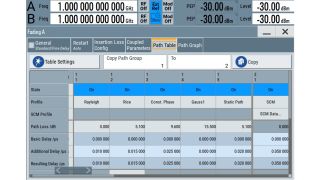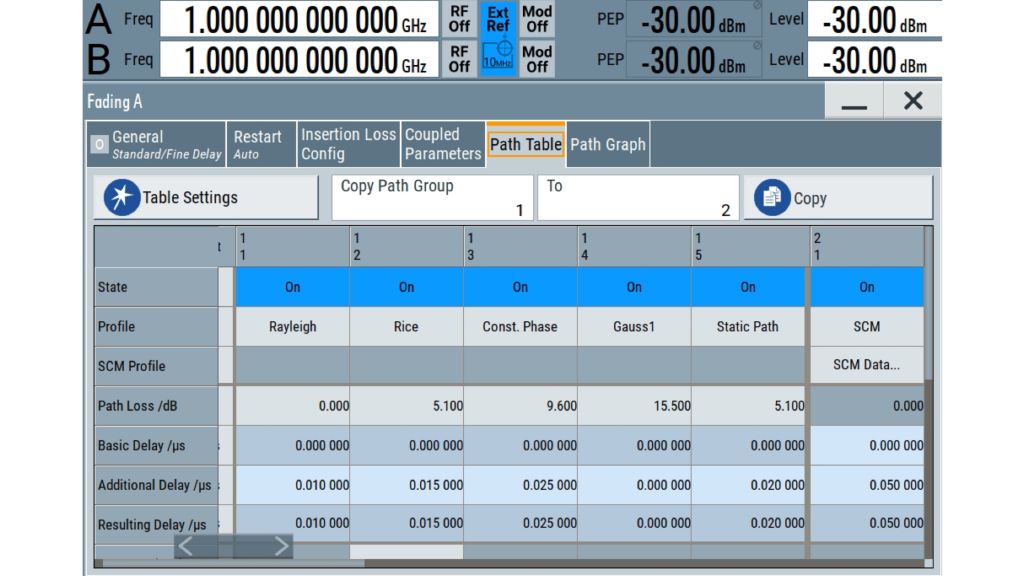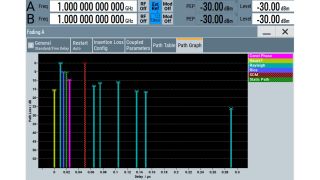MIMO fading simulation
Verify and optimize your product design under realistic fading conditions in a deterministic lab environment that allows repeatable measurements using standardized and user-defined fading profiles.

Verify and optimize your product design under realistic fading conditions in a deterministic lab environment that allows repeatable measurements using standardized and user-defined fading profiles.
You need to verify that your MIMO receiver is able to meet performance requirements under real-world conditions. Important criteria for the test setup include repeatability, test time and cost.
Background
Modern wireless communications systems require a robust receiver to combat the channel impairments in various deployment scenarios.
Fading is a major channel impairment that inevitably occurs in real life. It causes degradation of the receiver performance, which affects the end user’s experience. Signals arriving at the receiver through different propagation paths are superimposed constructively or destructively, causing fluctuations in the signal amplitude and phase. Under severe fading conditions, this can even disrupt the communications link. In wideband channels, multipath propagation can cause intersymbol interference (ISI), which dramatically impairs receiver performance.
To improve receiver immunity under various fading conditions and maximize receiver performance in a given deployment scenario, e.g. MIMO, it is essential to verify and optimize the performance of the MIMO receiver algorithm early at the chipset development stage. Conformance tests to verify compliance with standardized receiver performance requirements, e.g. in line with 3GPP and IEEE, and user-defined tests for quality assurance purposes also need to be conducted. However, carrying out these tests in the field can be challenging. Field tests do not offer adequate repeatability, plus they are cost and time consuming.
An alternative is to emulate real-world fading conditions in the lab by applying comprehensive fading profiles. In contrast to field tests, fading simulation in the lab provides controllable, scalable and repeatable test conditions that save substantial time and cost.


Conventional test setup for testing the performance of a 2x2 MIMO receiver.
Conventional test setup
A conventional test setup typically consists of one or more signal sources and an RF fader. The first figure on the next page shows a test scenario for 2x2 MIMO that consists of two single-channel signal generators – to deliver the two MIMO layer signals – and an external RF fader. This setup requires a large footprint (three instruments are needed in the given example). The bulky and expensive setup is also difficult to operate as multiple instruments need to be configured and controlled individually. Simple operations like RF output power level calibration become very complex. The footprint, cost and complexity of conventional test setups increase linearly with increasing MIMO order.


Compact test setup for testing the performance of a 2x2 MIMO receiver with an R&S®SMW200A vector signal generator.
The R&S®SMW200A, a high-end vector signal generator, supports multiple RF paths with optional integrated real-time baseband fading simulation – a state-of-the-art and compact solution. The R&S®SMW200A can generate and optionally fade up to eight individual baseband signals in a single box, offering fading bandwidths up to 800 MHz. Unlike conventional test setups, the R&S®SMW200A so-lution requires only one instrument for 2x2 MIMO and can be extended to support up to 8x8 MIMO by adding compact R&S®SGT100A RF extension units.
Benefits include:
Flexible extension of RF outputs using R&S®SGT100A units to support MIMO orders up to eight layers with centralized control on the R&S®SMW200A


Configuration of a multipath fading channel on the R&S®SMW200A.
Predefined channel models in line with 3GPP, IEEE and many other standards are available as presets. Many standard fading profiles (pure Doppler, Rayleigh, Rice, etc.) and delay profiles (birth-death, moving propagation, high-speed train, etc.) are also available. In addition, users can create custom fading and delay profiles. A typical use case is the stress test to improve receiver design and performance under extreme fading conditions.
Users can easily define and configure fading channels with various fading paths, each with a specific fading profile, path loss and path delay, via the associated dialog.


Graphical representation of the multipath fading channel configuration.
An intuitive graphical representation of the configured fading channel is provided to the user. Advanced deployment scenarios such as multi-user MIMO, carrier aggregation and MSR are also supported for both conducted and OTA test environments and can be easily configured via the instrument GUI.
The integrated fader on the R&S®SMW200A provides a compact one-box solution, making real-time fading simulation in the lab a simple and straightforward task. Easy and flexible simulation of fading scenarios not only enables standard-conformant receiver performance testing but also testing based on customized fading scenarios under controllable, repeatable and scalable conditions.